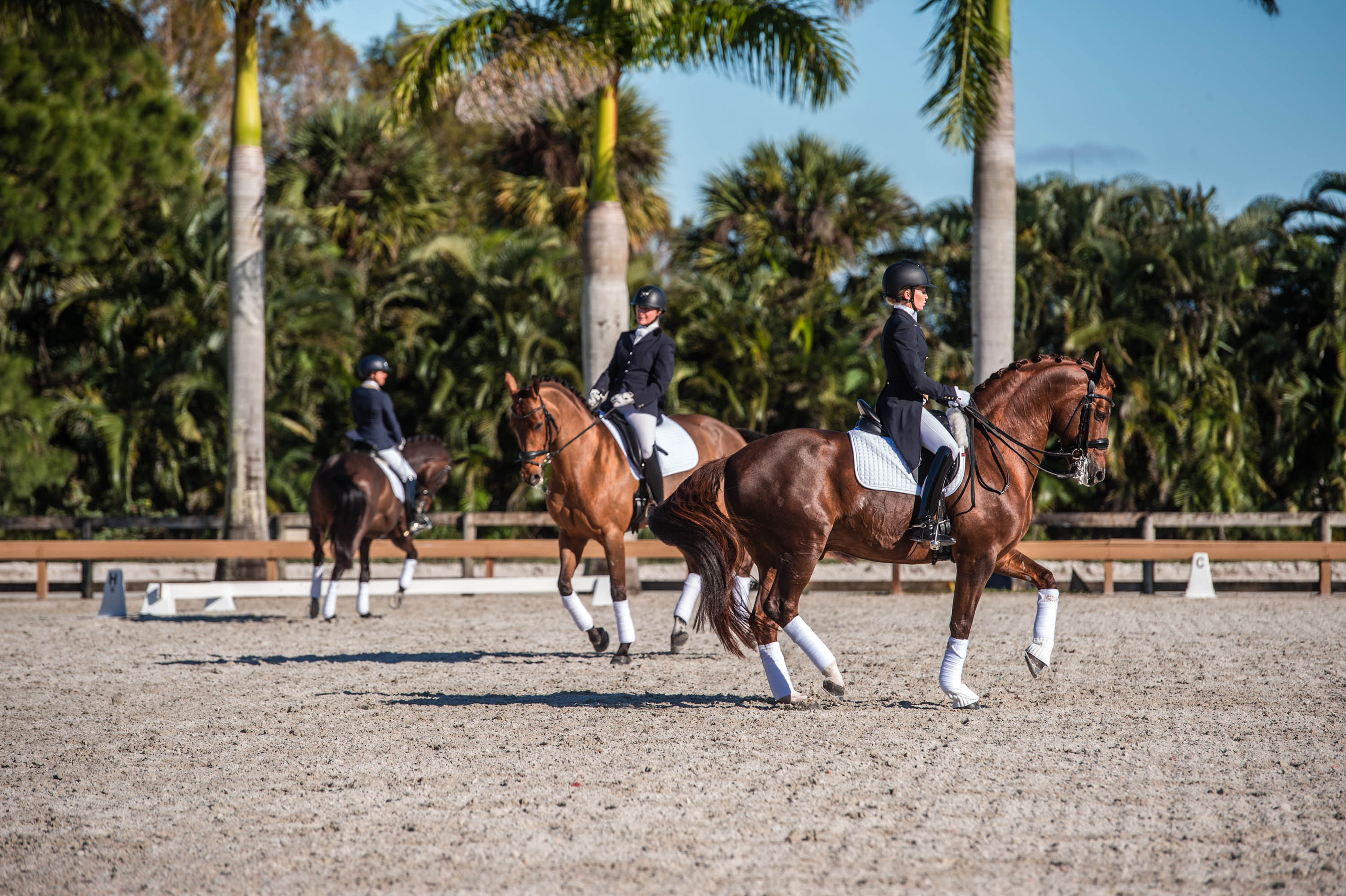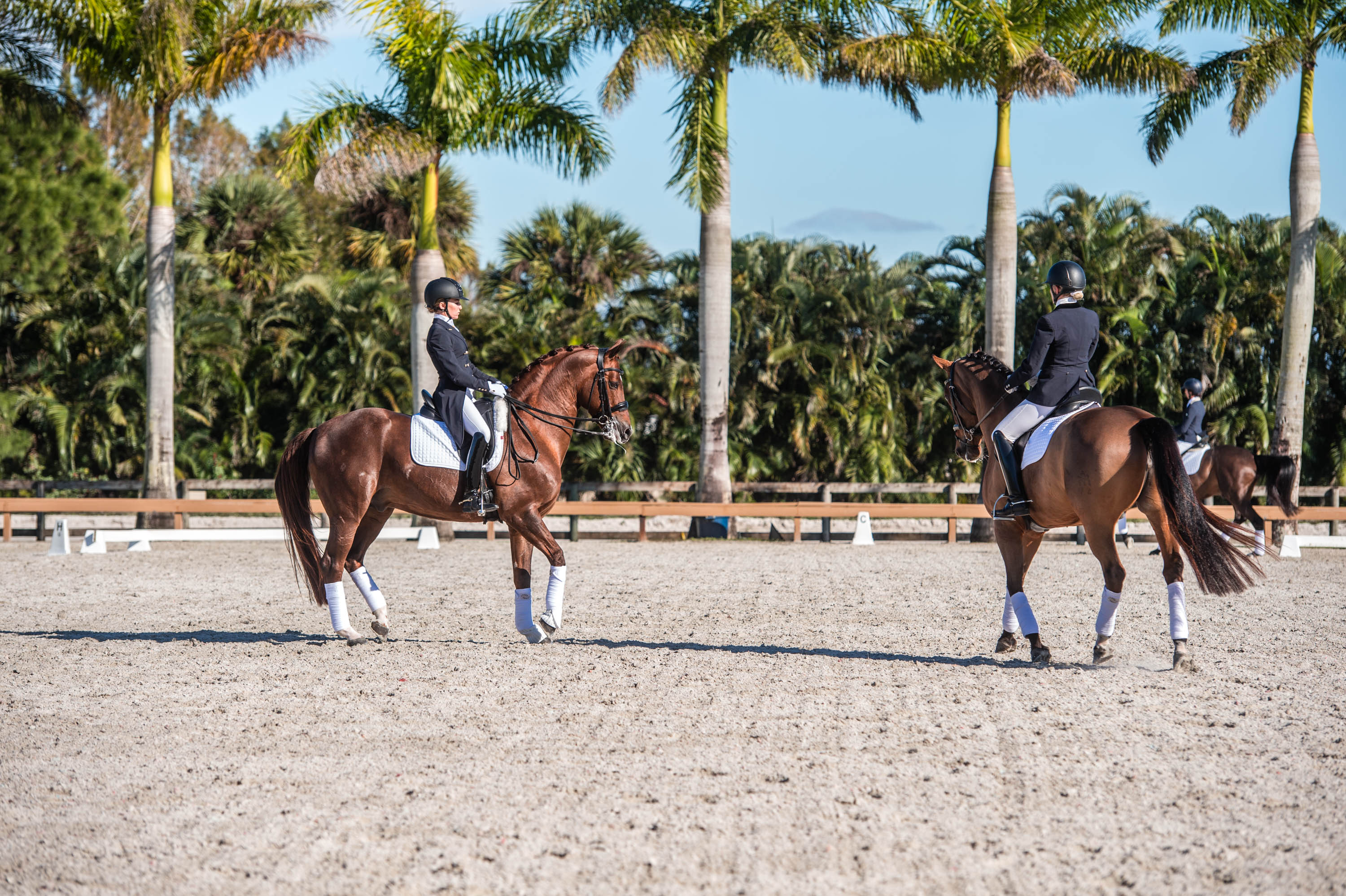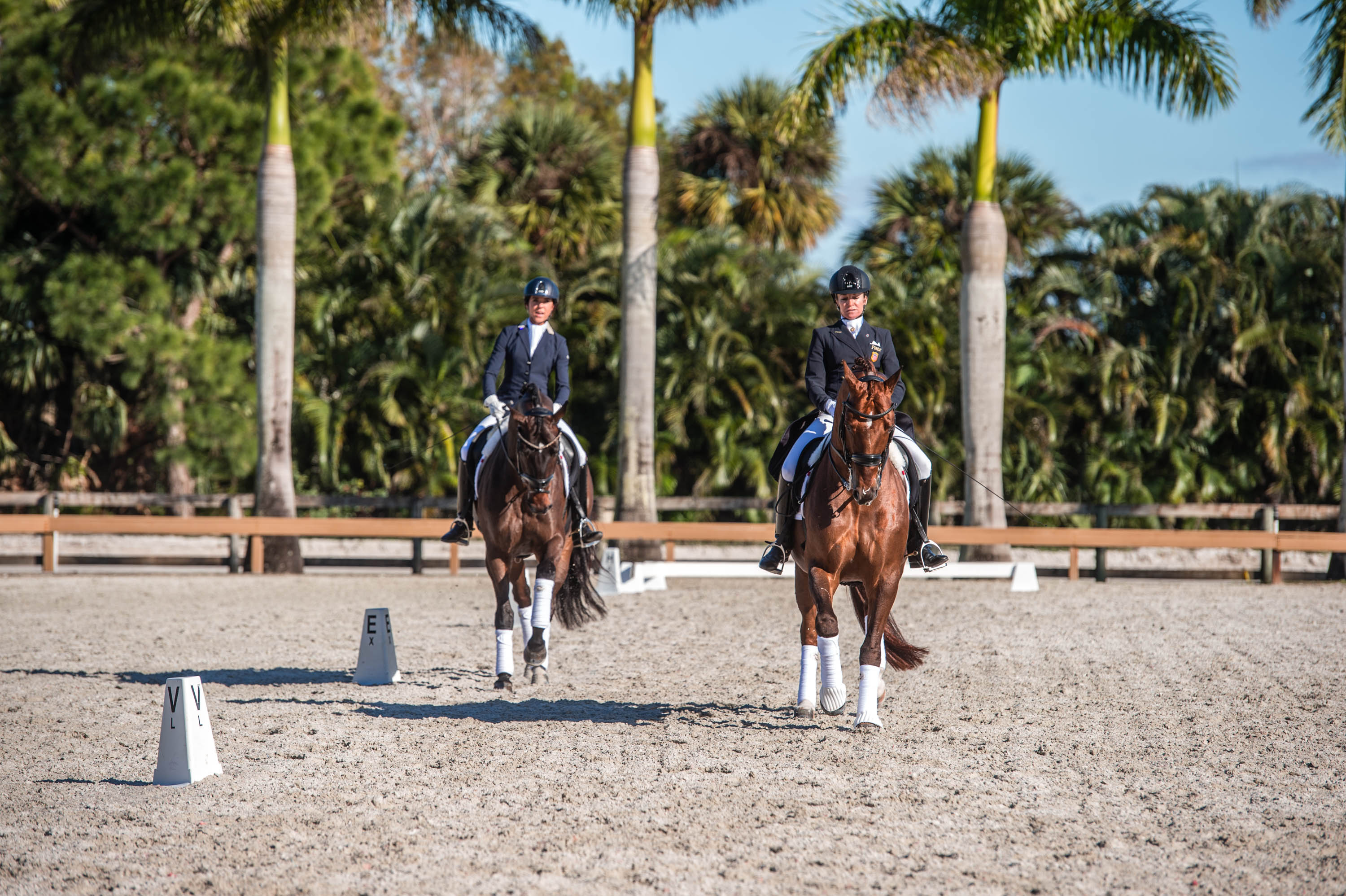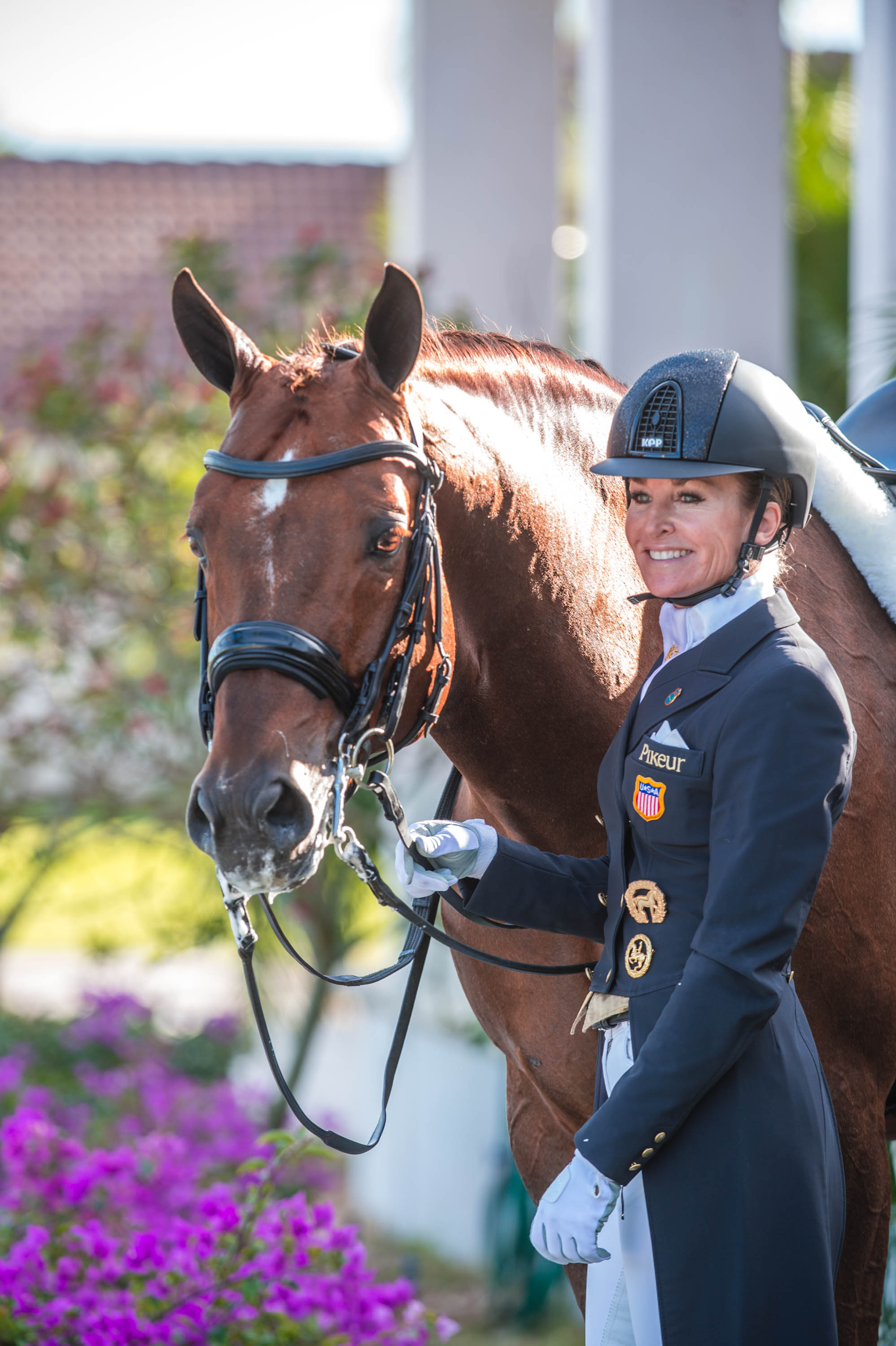
Today’s warm-up rings at dressage shows are crowded, chaotic and sometimes downright dangerous. I’ve witnessed near collisions, riders cutting each other off mid-movement and tension spreading from horse to horse like wildfire—at every level. In the worst-case scenarios, such mayhem can result in serious injuries. But even the mildest cases create situations that upset horses, disrupt riders’ focus and generally lower the quality of everyone’s performances.

The root of this problem is not overcrowding. In Europe, warm-up arenas are always jam-packed. If a rider commits an etiquette sin there, whether at home or at a show, her trainer will immediately reprimand her—and not always gently. From the beginning of every equestrian career in Europe, respect for other riders and the community as a whole is firmly ingrained.
I’d like to see this same standard adopted in the U.S. When warming up for a test, we all have the same goal: to relax our horses while gymnasticizing their bodies in preparation for the movements they have to perform. Competition jitters and the electricity of the show atmosphere already put most horses and riders on edge. The last thing anyone needs is more tension! Horses are very in tune with one another’s emotional states. So to minimize tension in our individual mounts, we need to act together as a community, treating each other courteously and considerately so that every horse in the arena feels a sense of calm and security.
I don’t believe that Americans lack respect or are inherently ruder than Europeans. We are simply less educated about ring etiquette and sometimes unaware of how our actions affect others. To rectify this situation, I suggest we all make a concerted effort to pay more attention to our own horses’ emotional states as well as to the horses and riders around us while following a few basic rules:
1. Take Off Your Blinders
The most important thing you can do is stop riding like you’re wearing blinders. We’re all concentrating on our own warm-up plans so it’s easy to forget to look up! Ask yourself, “Would I drive my car like this?” Pay attention to the riders around you and try to treat them as courteously as you’d like them to treat you.
It helps to familiarize yourself with the tests that other people are preparing for in your warm-up area. That way you can anticipate what movements they might do next. For example, if you know the test in the adjacent arena involves a three-loop serpentine and you see a rider initiate the first loop, you should have a pretty good idea of where the other loops will take her, so plan accordingly. Most show organizers try to group together riders of similar levels in each warm-up space, so you might already know some of the tests riders are practicing for the other rings.
As you begin your warm-up, observe the energy levels and auras of the horses and riders around you and consider how they might affect your horse. Horses are like school kids: They all have different personalities. Some are bullies; some are shy and easily intimidated. It’s very important to know your own horse’s character so you can try to predict how others will affect him—and vice versa. In the warm-up ring, pay attention to every horse’s body language, looking for signs of tension. If another horse starts to swish his tail violently as you approach, you’re probably too close. He might be about to kick at you—so get out of there quickly!
Take special note of any stallions in the ring. Some stallions are very easygoing around other horses, but many tend to be naturally protective of their “territory”—the space around them—and therefore more guarded than usual. They can be more easily distracted and upset by horses who come too close to them. Their hormones might drive them to nicker to mares—and sometimes even geldings—in their near vicinity. Do your best to give all stallions a wide berth (especially if you’re on a mare) to avoid influencing both their performance and your own horse’s.
2. Pass Left to Left, Yield to Committed Riders
When you’re approaching another rider head-on, always aim to pass her with your left shoulder facing her left shoulder. Imagine you’re driving on a road, keeping oncoming traffic on your left.
Of course, there are some exceptions to this rule. When another rider is clearly committed to a line, aim to pass her in whatever manner is least likely to interfere with her movement. So, for example, if you see someone performing tempi changes across the diagonal, don’t initiate a half-pass right in front of her.
When you yield to other riders committed to a line, consider how your presence might affect their horses not just physically but also mentally and emotionally. Say a horse is performing a half-pass. If you cut across his line of travel, he might lose focus. Or imagine a horse piaffing on the centerline, parallel to the short side of the arena. Even though the movement is performed “on the spot,” he should still appear forward-thinking. If you ride past his nose, his natural instinct might be to recoil and stall out. In turn, his rider will have to react with more leg or spur to regain the momentum. So, in essence, the horse gets punished because of you.
In cases like these, if you can’t pass other riders who already committed to lines or movements by a wide margin—at least a few meters—plan your own lines so that you pass behind, rather than in front of them. Give other riders every chance to complete an exercise successfully.
If you’re a more experienced rider, make an extra effort to watch out for lower-level riders. They might be less accustomed to the show atmosphere and therefore more easily rattled by a busy warm-up scene. You’re likely more skilled at maneuvering your horse through traffic than they are, too, so plan your track in the most predictable way possible and try to accommodate these newbies as much as you can.

3. Speak Up
It’s not always easy to predict what other riders are going to do next. So the more we communicate with one another, the better. Whenever there’s a chance of someone misinterpreting your track—or when you suspect you might be approaching a “headless horseman” (somebody clueless about what’s happening around her)—it’s always best to broadcast your intentions. When approaching someone from behind, call out “on your left” or “on your right.” Before you turn onto the diagonal, call out “diagonal.”
Sometimes riders unconsciously drift into each other’s lanes. If you sense this happening, make your presence known with a “Heads up on your left” or “On your right!” Even if you think a rider is aware of you, if you’re still worried that she’s getting too close, don’t be afraid to speak up.
Experienced riders learn to develop “eyes in the backs of their heads” to navigate traffic safely and smoothly. Until you reach that point, you may find it helpful to have your trainer or another helper serve as your eyes on the ground. Ask her to stand outside the arena and let you know what riders around you are doing. For example, she could call out loud to you, “It looks like this rider on the gray is going to turn across the diagonal, so make a circle.”
Speaking of speaking up, if another competitor is behaving in an extremely inconsiderate or dangerous manner, don’t be afraid to bring it to the ring steward’s attention. It’s the officials’ job to monitor the warm-up arenas and remind riders to be more conscientious of others when necessary. Remember, you paid a lot of money and put in a great deal of effort to come to this show. You have a right to a fair, safe warm-up.
4. Give Others Plenty of Space
When I see riders graze past each other within striking distance of a kick, my heart sinks. Yes, sometimes they get lucky and the horses don’t react. But whenever you put horses together in such close quarters, there’s always a risk of someone getting hurt. We only have to think back to Nicole Uphoff’s Olympic gold-medal partner Rembrandt, who sustained a hock fracture when he was kicked during an awards ceremony in 1993, to understand just how real this risk is.
Regardless of how trustworthy you think your horse and the others around him are, always maintain at least one horse length between him and any horse in front of him. When you overtake other riders or pass them head-on, keep at least two horse widths between you. If you can reach out and touch the other rider, you’re way too close.
Pay special attention to potential bottlenecks—for example, when you’re entering or exiting the arena or when multiple horses converge in one area. Stop, circle or otherwise change your track to avoid trapping your horse in a space that might be uncomfortably tight—for him or for the horses around him.
When you walk, move over to the inside, or “second,” track, far enough off the rail so somebody could easily perform a shoulder-in along it and still pass with two horse widths between you. Be very conscientious about where you perform walk movements such as pirouettes. Watch out for any riders who might unknowingly cross your line of travel.
If your warm-up space is a standard 20-by-60-meter arena, do all of your initial walking on a long rein outside the arena to avoid interfering with other riders working at faster gaits. Exit the arena when you take walk breaks, too. I even do most of my collected walk work outside of the 20-by-60-meter warm-up arena. There’s usually plenty of room and the footing is the same along the outside edges of the arena as it is inside. In fact, there’s quite a lot you can do outside the arena. You don’t need arena barriers to practice every movement. Just try to visualize the letters and parts of the arena (corners, centerline, etc.) in your mind as you ride. You’ll probably find this more productive than cramming yourself into an already packed warm-up ring.
5. Be Conscious of Your Own Aura
When you enter the warm-up arena, take notice of the other riders around you and consider how your presence might affect them. Some riders don’t even realize when they’re hogging the arena. This is not the place to ride through your entire test. You can do that plenty of times at home. To be fair to other competitors, break the test into sections and practice them one at a time.
This is not the place to correct your horse in a dramatic way. Always use your whip discreetly so as not to disrupt other horses. And avoid creating any situations that might upset others or put them at risk. Understand how you’re affecting the horses around you. If your horse is rearing, bucking, backing up uncontrollably or behaving in an otherwise unacceptable manner, be honest with yourself: You don’t belong at this show today. If you can’t correct him without disturbing others, go home and solve the problem there.
Strategies for Sensitive Horses
If you happen to be on a sensitive and/or claustrophobic horse, busy warm-up rings can make achieving the relaxation and preparedness that you hope to bring to your test difficult. It’s your job to make the world a safe place for him, so devise a strategy to protect him from unnecessary warm-up stress.
Start with your show and class selection. If you know a show has a reputation for having a high-energy atmosphere, think twice about taking your horse there. For example, if you have a Grand Prix horse who is a real hot tamale, instead of signing up for the evening Freestyle, where the bright lights and festive VIP tent might send him over the edge, choose the Special the next day. Don’t let things like potential prize money stop you from doing what’s right for your horse.
I’ve seen many timid horses put into warm-up arena situations that are not educational or confidence-building. Because a single bad experience can have a lasting impact on a horse’s career, I’m extremely cautious about when and where I show young horses. My recent Grand Prix partner, Galant, is a perfect example. He was very sensitive when I began working with him as a young horse. I knew he had the talent to become a top-level horse, but I worried that he wouldn’t be able to handle the high-pressure CDI warm-up scenarios, where you sometimes have 10 horses packed into a 20-by-60-meter arena. I skipped the Young Horse Dressage National Championships that he qualified for as a 6-year-old, thinking that his confidence level wasn’t high enough to cope with the chaotic warm-up atmosphere there. That decision paid off years later when his well-developed confidence allowed him to navigate CDI warm-up rings flawlessly.
Your job as your horse’s protector continues when you arrive on the showgrounds. From the moment you mount, keep a light contact with his mouth, imagining he’s a fish on the end of a line. Never walk around showgrounds on the buckle! If something grabs his attention—maybe the wind catches some flags or a tent flap—you want to be ready to control the situation. Take note of whatever he seems most aware of and use this information to navigate your warm-up plan.
If your sensitive horse is young and inexperienced, there’s no shame in asking a friend to attach a lead rope to his bit and lead you to the warm-up ring. I’ve done this many times on hot, easily stimulated young stallions. (I call it my “lead-line class.”) With so much going on, this is often the safest approach for everyone. Have your friend lead you around the grounds while you sit quietly in the saddle, patting his neck and soothing him with your voice. Stay outside the warm-up arena until he’s calm (it’s not fair to other riders to add this extra factor to the confusion), then have her unclip the lead and step away.
Sensitive horses are easily set off by other horses—especially big, intimidating ones. I’ve found that Friesians tend to fall into the latter category. They’re usually large and their high knee action, earth-pounding gaits and long, swishy leg hair create a dramatic picture. If you’re on a timid guy, he’s going to react to more dominant-appearing horses like these just the way a sensitive kid would behave when he passes a bully in the school hallway: He’s going to freeze. Try to understand his perspective and do your best to stay on the opposite end of the arena from that horse. This is not the day to force him to accept a battle of wills against a big, black Trojan horse.
Similarly, if you notice another horse who looks worried or scared, steer clear. That timid horse might upset your timid horse.
Keep these factors in mind as you rehearse different movements. Say you’re on a young horse who has to perform a single flying change in his test. Avoid practicing it when he’s facing another horse heading toward him. In that situation, he’s not going to hear your aids because he has to pay attention to this oncoming horse.
Also beware of small spaces, close calls and any situation in which your horse might get sandwiched between other horses, triggering a minor panic attack. If it’s unavoidable—for example, two horses are approaching you head-on and you have no choice but to pass between them—halt where you are and sit tight, patting him for reassurance. Stay calm and hold a steady contact on both reins in case he tries to spin away from the horses. You’ll feel him tense up and hold his breath as they go by. Wait for him to take a big breath afterward before riding off.
In very busy warm-up arenas, it’s sometimes difficult to find the opportunity and space to fit in every movement you intended to practice. Keep in mind the time you’ll have outside the show ring before the judge rings the bell. If your horse is on the sensitive and/or claustrophobic side, he’ll welcome this time with relief: “Ah, my own space!” Try not to get rigor mortis in front of the judges—they will not judge you until you enter the arena. Instead, seize this opportunity to squeeze in a little last-minute training: a canter-to-halt transition, trot lengthening, walk pirouette, passage-piaffe—whatever you think will make you feel most prepared to enter the ring, even if that means not practicing the exact count, for example, for a zig-zag or tempi changes.
Regardless of our horses’ characters and confidence levels, we will all benefit as a community if we practice better arena etiquette—both at home and at shows!
About Lisa Wilcox

Colorado-born Olympian Lisa Wilcox invested a large portion of her early dressage career training in Europe with some of the sport’s masters, including Herbert Rehbein and Ernst Hoyos. While residing in Germany, she passed the professional horse trainer, or Bereiter, and riding-instructor, or Reitlehrer, exams. She also served as the head trainer at Gestüt Vorwerk, one of Germany’s best-known Oldenburg stud farms, for seven years, riding such famous stallions as Rohdiamant, Royal Diamond and Relevant. She and Relevant won the individual silver medal at the 2003 Open European Championships and earned a team silver for the U.S. at the 2002 World Equestrian Games and a team bronze at the 2004 Olympics.
Lisa moved back to the U.S. in 2006 and started her own teaching and training business in Florida. In 2017, she won the World Cup Freestyle and Grand Prix at the Adequan Global Dressage Festival and posted the second-highest Grand Prix score at the Nations Cup in Wellington on Jacqueline Shear’s Galant. She also won the 2016 Palm Beach Derby National USEF Developing Horse class with Horses Unlimited’s stallion Gallant Reflection HU.
Read more about Lisa’s story and her plans for the future at PracticalHorsemanMag.com/personalities/lisa-wilcox-coming-back-to-america.
This article was originally published in the September 2018 issue of Practical Horseman.










